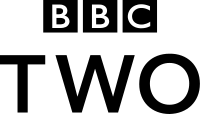Controller of BBC2
| BBC Two | |
|---|---|

BBC Two logo used from 2007
|
|
| Launched | 21 April 1964 |
| Owned by | BBC |
| Picture format |
576i (16:9 SDTV) 1080i (16:9 HDTV) |
| Audience share | 5.58% (February 2017, BARB) |
| Country | United Kingdom |
| Broadcast area | United Kingdom and Ireland |
| Headquarters | Broadcasting House, London |
| Formerly called | BBC2 (21 April 1964 – 3 October 1997) |
| Sister channel(s) |
BBC One BBC Four BBC News BBC Parliament CBBC CBeebies |
| Website | www |
|
Availability
|
|
| Terrestrial | |
| Freeview | Channel 2 Channel 102 (HD) |
|
Digitenne (Netherlands) |
Channel 20 |
| Satellite | |
| Freesat | Channel 102 (SD: Sco/Wal/NI; HD: England) Channel 109 (SD: England; HD: Sco/Wal/NI) Channels 968–971 (regional variations) |
| Sky (UK) | Channel 102 (SD: Sco/Wal/NI; HD: England) Channel 115 (HD: Sco/Wal/NI) Channel 141 (SD: England) Channels 969–972 (regional variations) |
| Sky (Ireland) | Channel 142 (SD/HD) Channel 143 (SD) |
| Astra 2E | 10773 H 22000 5/6 10847 V 23000 2/3 (HD) |
| BFBS | Channel 2 Channel 12 (Delayed) |
| Cable | |
| Virgin Media (UK) | Channel 102 Channel 162 (HD) |
| Virgin Media (Ireland) | Channel 109 Channel 140 (HD) |
| Ziggo (Netherlands) | Channel 62 (SD/HD) (England) |
| Naxoo (Switzerland) | Channel 214 |
| UPC Switzerland | Channel 156 |
| WightFibre | Channel 2 |
| Telenet (Belgium) | Channel 121 |
| IPTV | |
| KPN(Netherlands) | Channel 24 |
| Telfort(Netherlands) | Channel 24 |
| XS4ALL(Netherlands) | Channel 24 |
| Belgacom TV(Belgium) | Channel 68 (Brussels) Channel 24 (Flanders) Channel 214 (Wallonia) |
| Streaming media | |
| BBC iPlayer | Watch live (UK only) |
| TVPlayer | Watch live (UK only) |
| Horizon Go |
Watch live (Ireland only) Horizon.tv (Netherlands only) |
BBC Two is the second television channel operated by the British Broadcasting Corporation (BBC) in the United Kingdom, Isle of Man and Channel Islands. It covers a wide range of subject matter, but tending towards more "highbrow" programmes than the more mainstream and popular BBC One. Like the BBC's other domestic TV and radio channels, it is funded by the television licence, and is therefore commercial-free. It is a comparatively well-funded public service network, regularly attaining a much higher audience share than most public service networks worldwide.
Originally styled BBC2, it was the third British television station to be launched (starting on 21 April 1964), and from 1 July 1967, Europe's first television channel to broadcast regularly in colour. It was envisaged as a home for less mainstream and more ambitious programming, and while this tendency has continued to date, most special-interest programmes of a kind previously broadcast on BBC Two, for example the BBC Proms, now tend to appear on BBC Four instead.
A high-definition version of the channel launched on 26 March 2013, replacing BBC HD.
British television at the time of BBC2's launch consisted of two channels: the BBC Television Service and the ITV network made up of smaller regional companies. Both channels had existed in a state of competition since ITV's launch in 1955, and both had aimed for a populist approach in response. The 1962 Pilkington Report on the future of broadcasting noticed this, and that ITV lacked any serious programming. It therefore decided that Britain's third television station should be awarded to the BBC.
Prior to its launch, the new BBC2 was promoted on the BBC Television Service: the soon to be renamed BBC1. The animated adverts featured the campaign mascots "Hullabaloo", a mother kangaroo, and "Custard", her joey. Prior to, and several years after, the channel's formal launch, the channel broadcast "Trade Test Transmissions", short films made externally by companies such as Shell and BP, which served to enable engineers to test reception, but became cult viewing.
...
Wikipedia
